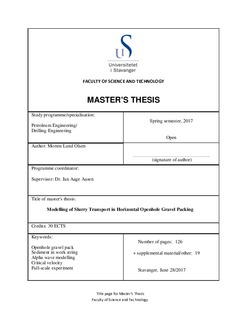| dc.contributor.advisor | Aasen, Jan Aage | |
| dc.contributor.author | Olsen, Morten Lund | |
| dc.date.accessioned | 2017-10-12T06:46:32Z | |
| dc.date.available | 2017-10-12T06:46:32Z | |
| dc.date.issued | 2017-06 | |
| dc.identifier.uri | http://hdl.handle.net/11250/2459785 | |
| dc.description | Master's thesis in Petroleum engineering | nb_NO |
| dc.description.abstract | The objective of this work is to study slurry transport in horizontal openhole gravel packing and to investigate the process of sedimentation, both inside work string and for alpha wave.
An attempt to quantify the amount of gravel deposited in the work string is made, since control of the gravel consumption is vital for the outcome of the operation, and uncontrolled sedimentation can cause unnecessary confusion during the packing process. A practical and straightforward method to quantify the gravel deposition in horizontal section of the work string is presented. Sedimentation is strongly affected by internal pipe diameter and pump rate, and these parameters should be carefully evaluated through operational planning. The utilization of the presented model could aid in designing the slurry transport, by selecting the ideal pump rate and work string specifications. Modelling for typical pipe sizes shows a lower limit for the pump rate where sedimentation arises.
Alpha wave design is a key factor for successful gravel packing, and the models typically used are either based on small-scale experiments or not specifically developed for gravel packing. Gruesbeck et al., Penberthy et al. and Oroskar and Turian models were used in this thesis to find the critical flow velocity. Estimating the actual flow velocity above alpha dune was performed using Gruesbeck et al. pressure drop balance and a proposed method for describing the flow rate split between the annuli. This allowed finding the corresponding alpha dune gravel fill for the distinct models. The true volumetric gravel fill percent was found based on data from the actual field case and compared to the modelled. Gruesbeck et al. showed the best fit. Oroskar and Turian model was not developed for gravel packing purpose, and results showed that it may not be suitable for the eccentric annular configuration encountered.
Modelling of flow velocity was done using friction loss based on wall roughness, and it is believed to represent the overall friction, rather than characterize the borehole wall. Results from the work string modelling suggest that the phenomenon of bed surface friction needs to be investigated further for alpha wave. It is a considerable contributor to the frictional pressure loss, especially for higher gravel fill percentages. Using borehole wall roughness to calculate friction factor might not give the best representation of the reality. To verify the flow rate split and investigate the bed friction influence, a full-scale experiment involving true diameters of screens and washpipe should be conducted, and a proposal for this is given in the thesis. | nb_NO |
| dc.language.iso | eng | nb_NO |
| dc.publisher | University of Stavanger, Norway | nb_NO |
| dc.relation.ispartofseries | Masteroppgave/UIS-TN-IPT/2017; | |
| dc.rights | Navngivelse 4.0 Internasjonal | * |
| dc.rights.uri | http://creativecommons.org/licenses/by/4.0/deed.no | * |
| dc.subject | petroleumsteknologi | nb_NO |
| dc.subject | petroleum engineering | nb_NO |
| dc.subject | boreteknologi | nb_NO |
| dc.subject | openhole gravel pack | nb_NO |
| dc.subject | sediment in work string | nb_NO |
| dc.subject | alpha wave modelling | nb_NO |
| dc.subject | critical velocity | nb_NO |
| dc.subject | full-scale experiment | nb_NO |
| dc.title | Modelling of Slurry Transport in Horizontal Openhole Gravel Packing | nb_NO |
| dc.type | Master thesis | nb_NO |
| dc.subject.nsi | VDP::Technology: 500::Rock and petroleum disciplines: 510::Petroleum engineering: 512 | nb_NO |

